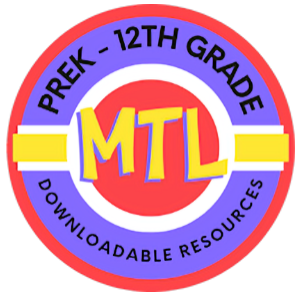Showing 1–20 of 42 results
-
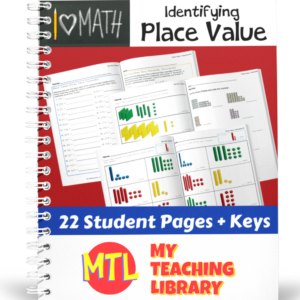 $3.25Buy Now
$3.25Buy NowHelp students learn to identify place value with this math resource! With 22 progressive student pages, students’ skill and understanding will increase.
The unit begins with students visually counting ‘ones’, then ‘tens’, then ‘hundreds’ using number blocks. Next, they proceed to identifying the place value of given numbers, beginning with 2 digit numbers (identifying ones and tens), then 3 digits (identifying ones, tens and hundreds) and finally 4 digits (identifying ones, tens, hundreds and thousands).
Perfect for use with multiple ages / grades or for differentiation. (Grades: 1st. 2nd and 3rd)
-
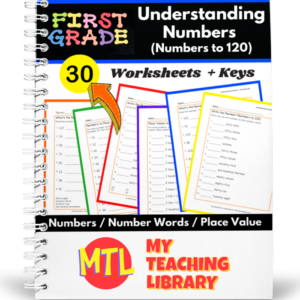 $3.50Buy Now
$3.50Buy NowGive students the practice they need to truly understand converting numbers (to 120) from standard numbers to number words, number words to standard numbers, as well as to be able to show they understand what the place value of each digit in a standard number represents. These math skills need repeated practice to help students master these skills and this product includes 30 student pages to give them this practice! This product has also some worksheets with answer banks and some without. This will allow for differentiation if needed or to use at various times along the students’ learning journey.
What you get:
- – 5 worksheets: Students given standard numbers and must write the number words (w/ answer bank)
- – 5 worksheets: Students given standard numbers and must write the number words (no answer bank)
- – 5 worksheets: Students given number words and must write the standard number of each (w/ answer bank)
- – 5 worksheets: Students given number words and must write the standard number of each (no answer bank)
- – 5 worksheets: Students are given a set of numbers and place values of each and students must write the standard number that is represented (example: Given 9 tens + 2 ones / Students are to write 92)
- – 5 worksheets: Students are give a standard number and must breakdown and write the place values of each digit (example: Give 85 / Students are to write 8 tens 5 ones)
- – Answer Keys
-
 $1.50Buy Now
$1.50Buy Now15 Worksheets on place value (ones & tens).
Pictures are displayed using base 10 rods and units.
-
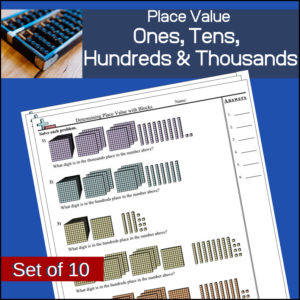 $1.25Buy Now
$1.25Buy Now10 Worksheets on place value (ones, tens, hundreds, thousands)
Pictures are displayed using base 10 blocks.
-
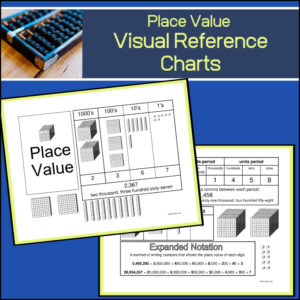 $2.00Buy Now
$2.00Buy NowThis b/w resource includes two reference posters that will allow your students to visually see (and learn) about place value!
The first poster clearly displays place value (using base ten blocks) for ones, tens, hundreds and thousands.
The second poster displays a table showing place value up through a hundred million as well as explains how to write expanded notation.
-
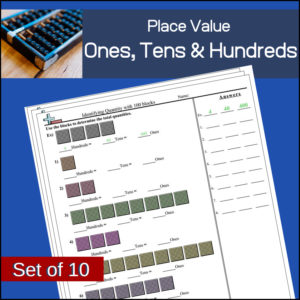 $1.25Buy Now
$1.25Buy Now10 Worksheets on place value (ones, tens, hundreds).
Pictures are displayed using base 10 blocks.
-
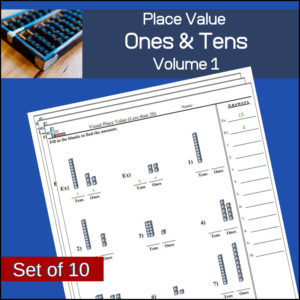 $1.25Buy Now
$1.25Buy Now10 Worksheets on place value (ones & tens).
Pictures are displayed using base 10 rods and units.
-
 $5.00Buy Now
$5.00Buy NowIn this unit, students work toward the goal of fluently adding and subtracting within 1,000. They use mental math strategies developed in grade 2 and learn algorithms based on place value. Students work with a variety of algorithms, starting with those that show expanded form, and moving toward algorithms that are more streamlined and closer to the standard algorithm. Understanding of place value also comes into play as students round numbers to the nearest multiple of 10 and 100. Students do not need to know a formal definition of “multiples” until grade 4. At this point, it is enough to recognize that a multiple of 10 is a number called out when counting by 10, or the total in a whole-number of tens (such as 8 tens). Likewise, a multiple of 100 is a number called out when counting by 100, or the total in a whole-number of hundreds (such as 6 hundreds). Students use rounding to estimate answers to two-step problems and determine if answers are reasonable.
Includes: Student and Teacher Editions
Size: 374 pages -
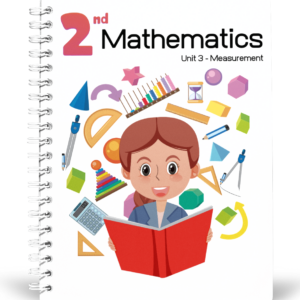 $5.00Buy Now
$5.00Buy NowThis unit introduces students to standard units of lengths in the metric and customary systems: centimeters, meter, inches, and feet. They examine how different measuring tools represent length units, learn how to use the tools, and gain experience in measuring and estimating the lengths of objects. Along the way, students notice that the length of the same object can be described with different measurements and relate this to differences in the size of the unit used to measure. Throughout the unit, students solve one- and two-step story problems involving addition and subtraction of lengths. To make sense of and solve these problems, they use previously learned strategies for adding and subtracting within 100, including strategies based on place value. To close the unit, students learn that line plots can be used to represent numerical data. They create and interpret line plots that show measurement data and use them to answer questions about the data. Students relate the structure of a line plot to the tools they used to measure lengths. This prepares students for the work in the next unit, where they interpret numbers on the number line as lengths from 0. The number line is an essential representation that will be used in future grades and throughout students’ mathematical experiences.
Includes: Student and Teacher Editions
Size: 372 pages -
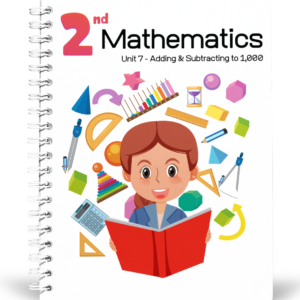 $5.00Buy Now
$5.00Buy NowIn this unit, students add and subtract within 1,000, with and without composing and decomposing a base-ten unit. They apply the methods they know and their understanding of place value and three-digit numbers to find sums and differences within 1,000. Initially, students add and subtract without composing or decomposing a ten or hundred. Instead, they rely on methods based on the relationship between addition and subtraction and the properties of operations. They make sense of sums and differences using counting sequences, number relationships, and representations (number line, base-ten blocks, base-ten diagrams, and equations). As the unit progresses, students work with numbers that prompt them to compose and decompose one or more units, eliciting strategies based on place value. Students learn to recognize when composition or decomposition is a useful strategy when adding or subtracting by place. In the later half of the unit, they encounter lessons that encourage them to think flexibly and use strategies that make sense to them based on number relationships, properties of operations, and the relationship between addition and subtraction.
Includes: Student and Teacher Editions
Size: 396 -
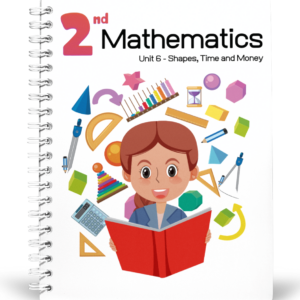 $6.00Buy Now
$6.00Buy NowIn this unit, students transition from place value and numbers to geometry, time, and money. They continue to look at attributes of a variety of shapes and see that shapes can be identified by the number of sides and vertices (corners). Students then study three-dimensional (solid) shapes, and identify the two-dimensional (flat) shapes that make up the faces of these solid shapes. Next, students look at ways to partition shapes and create equal shares. They extend their knowledge of halves and fourths (or quarters) from grade 1 to now include thirds. As they develop the language of fractions, students also recognize that a whole can be described as 2 halves, 3 thirds, or 4 fourths, and that equal-size pieces of the same whole need not have the same shape. Later, students use their understanding of halves and fourths (or quarters) to tell time. To continue to build fluency with addition and subtraction within 100, students conclude the unit with a money context.
Includes: Student and Teacher Editions
Size: 501 pages -
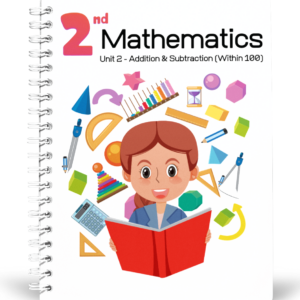 $5.00Buy Now
$5.00Buy NowIn this unit, students add and subtract within 100 using strategies based on place value, the properties of operations, and the relationship between addition and subtraction. Students begin by using any strategy to find the value of sums and differences that do not involve composing or decomposing a ten. They are then introduced to base-ten blocks as a tool to represent addition and subtraction and move towards strategies that involve composing and decomposing tens. Students develop their understanding of grouping by place value, and begin to subtract one- and two-digit numbers from two-digit numbers by decomposing a ten as needed. They apply properties of operations and practice reasoning flexibly as they arrange numbers to facilitate addition or subtraction. At the end of the unit, students apply their knowledge of addition and subtraction within 100 to solve one- and two-step story problems of all types, with unknowns in all positions. To support them in reasoning about place value when adding and subtracting, students may choose to use connecting cubes, base-ten blocks, tape diagrams, and other representations learned in earlier units and grades.
Includes: Student and Teacher Editions
Size: 336 pages -
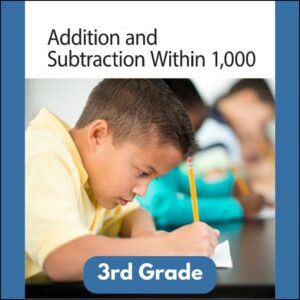 $2.00Buy Now
$2.00Buy NowIn this unit, student work toward the goal of fluently adding and subtracting within 1,000. They will use mental strategies as well as learn algorithms based on place value. By the end of this unit, students will also use rounding to estimate answers to two-step problems and determine if answers are reasonable.
This resource includes both student and teacher materials.
Number of Lessons: 20 and 1 optional
Lesson Time: Approximately 60 minutes. Please note that each lesson is designed for one instructional block, and may be divided into shorter or longer segments based on teacher pacing and student needs.See description below for more details.
-
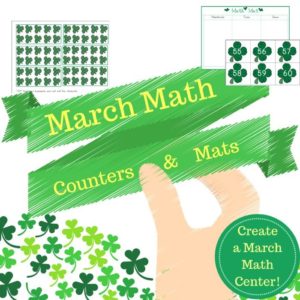 $2.00Buy Now
$2.00Buy NowMarch Math Center Materials includes shamrock number cards (1 – 100 plus blanks to add numbers), counters (individual and groups of ten), and math mats (addition, subtraction, multiplication, division, counting, and place value).
-
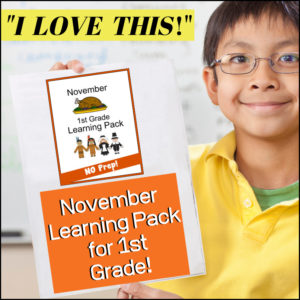 $4.99Buy NowNovember NO PREP Print and Go Learning Pack for 1st Grade! Over 90 pages of learning.Math: Fractions, Patterns, Counting, Place Value, Skip Counting, Counting Money (Nickels and Quarters), Word Problems, Reading Graphs/Coordinates, Single digit addition and subtraction, Telling timeLanguage Arts: Writing, Reading Skills, Rhyming, Phonics, Syllables, ABC Order,Critical Thinking Skills with November themed puzzles, Crafts…and more!!
$4.99Buy NowNovember NO PREP Print and Go Learning Pack for 1st Grade! Over 90 pages of learning.Math: Fractions, Patterns, Counting, Place Value, Skip Counting, Counting Money (Nickels and Quarters), Word Problems, Reading Graphs/Coordinates, Single digit addition and subtraction, Telling timeLanguage Arts: Writing, Reading Skills, Rhyming, Phonics, Syllables, ABC Order,Critical Thinking Skills with November themed puzzles, Crafts…and more!! -
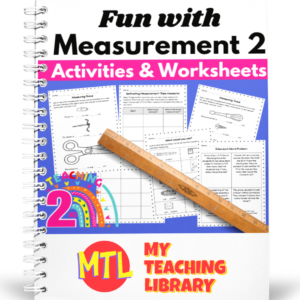 $2.50Buy Now
$2.50Buy NowHands-on activities and worksheets designed for 2nd grade students learning measurement skills such as using a variety of measurement tools (ruler, yardstick, meter stick and tape measure), finding two different measurements for objects (inches and centimeters), estimating measurements, and solving measurement word problems (with bonus if converting inches to feet and inches).
-
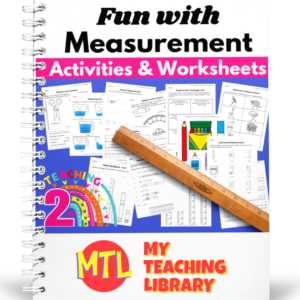 $3.50Buy Now
$3.50Buy NowHands-on activities and worksheets designed for students learning measurement skills such as:
- – Reading a ruler and using to measure objects (inches and centimeters)
- – Determining the best measurements (inches, feet, yards, miles / ounce, pounds / centimeter, meter, kilometer)
- – Tools of measurement
- – Reading a measuring cup
- – Comparing objects that have been measured
-
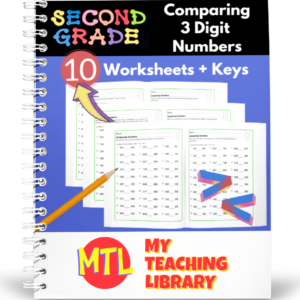 $1.75Buy Now
$1.75Buy NowThis set of no prep, 10 worksheets will give students the practice they need to compare three digit numbers. Students will be asked to use greater than, less than or an equal sign (<, > or =) for each pair of numbers. Each worksheet includes 30 number pairs to compare. Answer keys are included.
-
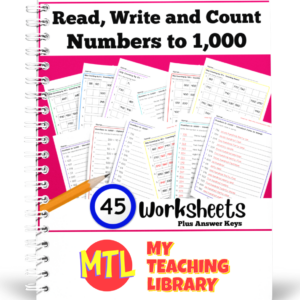 $3.50Buy Now
$3.50Buy NowThis resource will give students the opportunity to:
- – Display their understanding that the three digits of a three-digit number represent amounts of hundreds, tens, and ones; e.g., 706 equals 7 hundreds, 0 tens, and 6 ones by converting numbers to expanded form as well as full expanded form (numbers to 1000)
- – Show their ability to skip count by 5s, 10s, and 100s (numbers to 1000)
- – Read and write numbers to 1000 using base-ten numerals, number names, expanded form and full expanded form
This resource includes 45 worksheets plus answer keys:
- 5 Worksheets by 5s – Counting up
- 5 Worksheets by 5s – Counting down
- 5 Worksheets by 10s – Counting up
- 5 Worksheets by 10s – Counting down
- 3 Worksheets by 100s – Counting up
- 2 Worksheets by 100s – Counting both up and down
- 5 Worksheets – Given words to covert to standard form
- 5 Worksheets – Given standard form to covert to words
- 5 Worksheets – Given expanded form to covert to standard
- 5 Worksheets – Given standard form to convert to full expanded notation
-
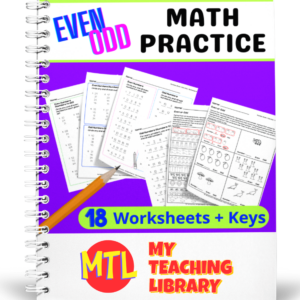 $3.00Buy Now
$3.00Buy NowGive students the practice they need to identify even and odd numbers! This resource includes 18 worksheets that progressively include higher numbers to really help students solidify their understanding.
Includes:
- – 4 worksheets (#’s to 20) w/ pictures: Students are to count and write how many, then create pairs (to determine if the number is even or odd) and then will circle even or odd.
- – 3 worksheets (#’s to 20) for students to identify odd numbers (given a sets of 6 numbers, they will circle every odd number)
- – 3 worksheets (#’s to 20) for students to identify even numbers (given a sets of 6 numbers, they will circle every even number)
- – 2 worksheets (#’s to 20) for students to identify both even and odd numbers (given a sets of 4 numbers, they will circle every even or odd number based on instructions given)
- – 4 worksheets (#’s to 50) for students to identify both even and odd numbers (given a sets of 4 numbers, they will circle every even or odd number based on instructions given)
- – 2 worksheets (#’s to 120) for students to identify both even and odd numbers (given a sets of 3 numbers, they will circle every even or odd number based on instructions given)
- – Answer Keys
Although 2nd grade skills require that students can identify even and odd numbers through 20, it is easy for them to go beyond twenty using this resource and the concepts they learn! Perfect to pair with Math Posters | Even – Odd Numbers
- – 4 worksheets (#’s to 20) w/ pictures: Students are to count and write how many, then create pairs (to determine if the number is even or odd) and then will circle even or odd.
